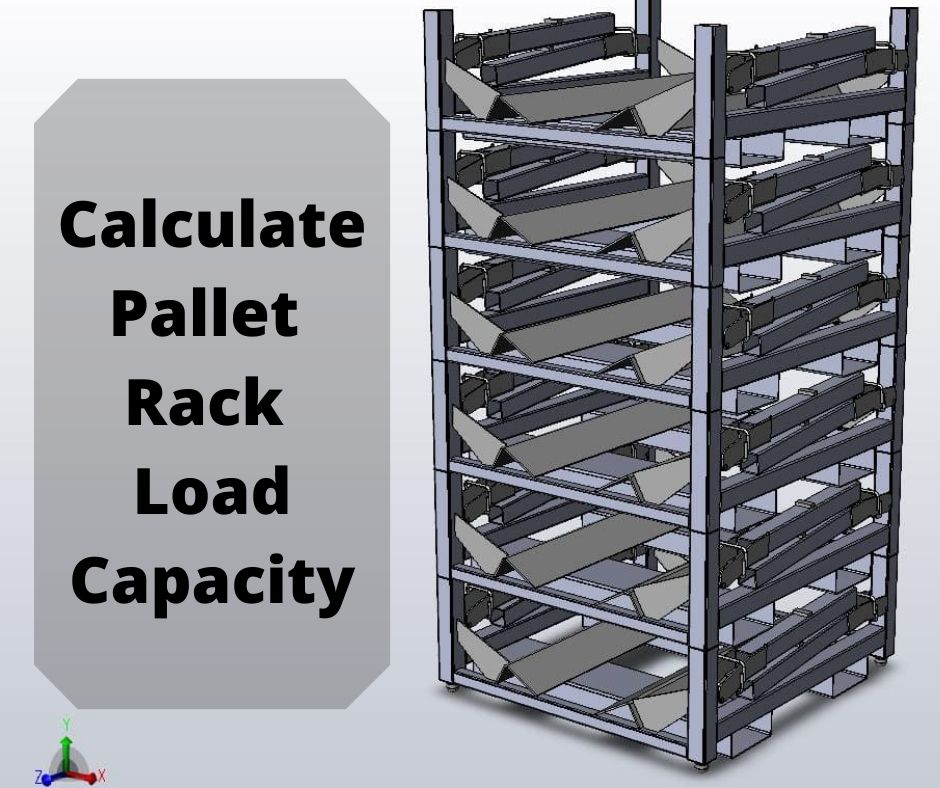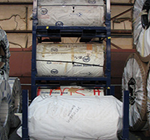How to Calculate Pallet Rack Load Capacity?
When it comes to pallet racks, safety and efficiency are of paramount importance. These material handling solutions are being largely employed at warehouses to stock products of varying loads. Each pallet racking solution is rated for specific loads and it is imperative for the user to stringently follow the manufacturer’s instruction when stocking loads. Stacking items rather than the rated capacity leads to rack collapse, posing injury and even death to those working in the vicinity. Hence, as a user, you are responsible to consider the pallet rack capacity and stack the items accordingly. How to calculate the pallet rack capacity to guarantee the safe storage of products for a long time? Have a look at below points.

Understanding Pallet Rack Load Capacity for Safe Operation
Pallet rack load capacity is crucial for ensuring the safety and efficiency of warehouse operations. Understanding and managing the load capacity properly helps prevent accidents, equipment damage, and disruptions to workflow. Here are the key points to consider when evaluating pallet rack load capacity for safe operation:
Definition of Load Capacity:
- Refers to the maximum weight a pallet rack can safely support without compromising its structural integrity.
- Exceeding the load capacity can lead to rack failure, causing product loss, operational delays, and potential injury.
Manufacturer Guidelines:
- Always follow the load capacity limits specified by the manufacturer.
- These limits take into account both the horizontal beams and vertical frames of the pallet racking system.
Impact of Overloading:
- Overloading racks or unevenly distributing loads can cause stress on specific areas of the structure, leading to potential collapse.
- Consistently monitor the weight distribution to ensure safe storage.
Key Factors Influencing Pallet Rack Load Capacity:
- Beam and Frame Design: Load capacity depends on the materials, thickness, and dimensions of the beams and frames.
- Load Distribution: Ensuring even distribution of weight across the racking levels prevents excessive pressure on individual components.
- Warehouse Flooring: The foundation beneath the racks must be capable of supporting the combined weight of the loaded racking system.
Know About Two Significant Calculations for Pallet Rack Load Capacity
To ensure a safe, efficient rack operation, it is imperative to calculate the capacity of your pallet rack frame and pallet rack beam. Calculating the capacity of these components brings you an overall idea of the capacity of your racking solution.
- Calculating the Capacity of Pallet Rack Beams: To calculate the capacity of beams, you must first determine the type of pallet or load you prefer to store on them. You must have an idea about how much weight will be stored in each beam. For example, if you are planning to store three pallets with loads 1000 lbs each, then the beam capacity must be minimum 3000 lbs or much more.
- Calculating the Capacity of Pallet Rack Frame: Measuring the vertical beam spacing would be the first step in determining the capacity of the pallet frame. Calculating the beam spacing is simple and you would just need to measure from the top of one beam level to the top the next beam level. For instance, if the calculated vertical beam spacing comes at 80 inches, then the frame capacity should be considered as 80 lbs.
Rather than the ones mentioned above, there are several other factors that determine the pallet rack weight capacity system. The flooring of your warehouse must also be considered as it is the base on which the entire load is placed. The other factors to be considered include:
- Type of steel used in the construction of racking components
- Strength and thickness of the steel
- Quality of the steel
- Rack upright height, width, gauge, pattern
- Foot plate size
- Beam level and load distribution
Load Capacity Verification and Safety Margin
Ensuring the safe operation of pallet racking systems requires rigorous racking capacity verification and the incorporation of safety margins. This process involves several key considerations:
Conducting Load Tests to Verify the Calculated Load Capacity:
Before implementing a pallet racking system, load tests are essential to verify the accuracy of the calculated load capacity. Load tests involve placing the expected loads on the racking and monitoring its response under different conditions. By comparing the actual results with the calculated capacity, warehouses can confirm the reliability and safety of the racking system.
Applying Safety Factors and Considering Future Growth and Load Changes:
To account for uncertainties and unexpected load variations, applying safety factors is crucial. Safety factors add an additional margin to the pallet racking calculator, providing a buffer against potential overloading. Factors such as dynamic loads, seismic considerations and future growth projections should also be taken into account when determining the appropriate safety margin.
The Importance of Regular Inspections and Load Capacity Reevaluations:
Load capacity verification is not a one-time task; it requires periodic inspections and reevaluations. Regular inspections help identify signs of wear, damage, or changes in load requirements. As warehouses evolve with varying storage needs, reevaluating the pallet racking load capacity ensures that it remains aligned with current operational demands and safety standards.
How to Accurately Determine Pallet Racking Weight Capacity
Accurately determining the weight capacity of a pallet racking system is essential to ensure safety, avoid overloading, and maintain operational efficiency in a warehouse. The process involves calculating the capacity of both the horizontal beams and vertical frames, along with other critical factors. Here’s a breakdown of how to determine pallet racking weight capacity:
Determine Beam Weight Capacity
- Identify the Load Type and Weight: Start by identifying the type of load to be stored on the beams. Calculate the total weight that each beam level will need to support. For example, if you store three pallets of 1000 lbs each, the beam must have a minimum weight capacity of 3000 lbs.
- Consider Load Distribution: Ensure that the load is evenly distributed across the beam length to prevent uneven pressure and potential bending or failure. Uneven load distribution can significantly reduce the beam’s capacity.
- Consult Manufacturer’s Specifications: Always refer to the manufacturer’s specifications for the weight capacity of the beam. These specifications are based on factors such as the material, thickness, and design of the beam.
Determine Frame Weight Capacity:
- Measure Vertical Beam Spacing: The distance between two consecutive beam levels, known as vertical beam spacing, plays a crucial role in determining the frame’s capacity. The larger the spacing, the more pressure the frame must support.
- Consider Frame Height and Design: The height of the frame, its width, and the thickness (gauge) of the steel used affect the overall weight capacity. Taller frames may have lower weight capacity due to greater leverage.
- Account for Upright Patterns and Foot Plate Size: Upright frames often have specific patterns designed to enhance their strength. Additionally, foot plate size and the surface area they cover also impact the frame’s ability to safely support loads.
Account for Additional Factors:
- Steel Quality: The quality of the steel used in both beams and frames directly impacts weight capacity. Stronger, higher-grade steel increases the overall load capacity.
- Environmental Conditions: Environmental factors like seismic activity or constant forklift traffic may require adding a safety margin to the calculated capacity. In areas prone to earthquakes, for example, additional reinforcements and adjustments may be necessary.
Conduct Load Tests:
- Verify Calculated Capacity: Conduct real-world load tests to confirm that your calculated weight capacity holds up under actual operating conditions. Testing under typical and maximum load scenarios ensures the system’s reliability and safety.
- Apply Safety Margins: Adding a safety factor to your calculated capacity helps account for unexpected changes in load or other variables. This buffer ensures that the racking system remains safe even under fluctuating conditions.
Regular Monitoring and Reevaluation:
Inspect and Recalculate as Needed: Over time, warehouse needs may change, including the types of products being stored and their weight. Regularly inspect and recalculate the weight capacity of your pallet racking system to ensure it continues to meet operational and safety requirements.
Key Factors Affecting Warehouse Racking Weight Capacity
Several critical factors influence the overall warehouse racking weight capacity, each of which must be carefully considered during planning and installation:
- Type and Quality of Steel: The strength, grade, and thickness of the steel used in constructing the racking components directly affect the load-bearing capacity. High-quality, thicker steel will support heavier loads compared to lower-grade materials.
- Upright Frame Design: The height, width, and gauge of the upright frames play a significant role in determining weight capacity. Taller racks may have reduced capacity due to increased leverage, and narrow frames may buckle under excessive load if not properly reinforced.
- Foot Plate Size and Floor Conditions: The size of the foot plate and the strength of the warehouse flooring also affect the system’s ability to handle weight. A strong foundation is essential for safely distributing heavy loads.
- Load Distribution: Even distribution of weight across the racking system prevents undue stress on certain sections of the rack. Uneven loading can lead to structural failure, so it’s important to distribute loads equally across all beams and levels.
- Environmental and Dynamic Forces: External forces such as seismic activity, temperature fluctuations, or the movement of forklifts can impact the weight capacity. Systems in regions prone to earthquakes, for example, require additional safety margins and reinforced racking to account for potential dynamic loads.
If you are confused to use the correct shipping pallet rack selection that best matches your load requirements, then consider speaking and partnering with a leading rack manufacturer like SPS Ideal Solution. Over the years, the company has successfully delivered various racking solutions for critical applications in custom specifications. The company provides the pallet rack capacity system only after carefully considering the load requirements and other details.
Related Posts:
- A Comprehensive Guide on Pallet Rack Flue Spaces
- How to Avoid Pallet Racking Mistakes?
- 7 Important Warehouse Pallet Racking Tips to Maximize Productivity
- How to Optimize the Space on Pallet Rack System?
About The Author











